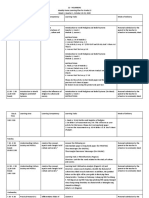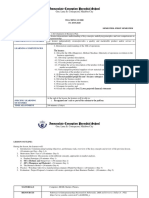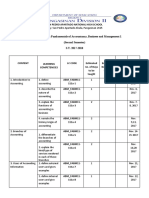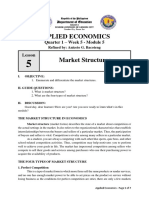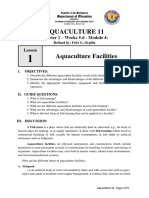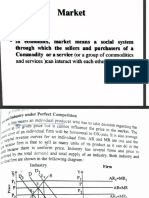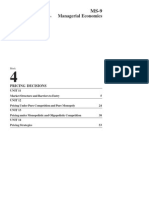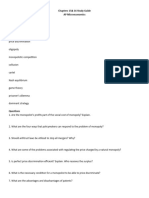Applied-Econ Q1 W5 M5 LDS Market-Structures ALG RTP
Applied-Econ Q1 W5 M5 LDS Market-Structures ALG RTP
Uploaded by
Helen SabuquelCopyright:
Available Formats
Applied-Econ Q1 W5 M5 LDS Market-Structures ALG RTP
Applied-Econ Q1 W5 M5 LDS Market-Structures ALG RTP
Uploaded by
Helen SabuquelOriginal Description:
Copyright
Available Formats
Share this document
Did you find this document useful?
Is this content inappropriate?
Copyright:
Available Formats
Applied-Econ Q1 W5 M5 LDS Market-Structures ALG RTP
Applied-Econ Q1 W5 M5 LDS Market-Structures ALG RTP
Uploaded by
Helen SabuquelCopyright:
Available Formats
Republic of the Philippines
Department of Education
REGION I
SCHOOLS DIVISION OF CANDON CITY
Candon City, Ilocos Sur
APPLIED ECONOMICS
Quarter 1 – Week 5 - Module 5
Refined by: Aniceto G. Bacoteng
Lesson
Market Structures
5
I. OBJECTIVE:
1. Enumerate and differentiate the market structures.
II. GUIDE QUESTIONS:
1. What is market structure?
2. What are the four types of market structure?
II. DISCUSSION:
Good day, dear learners! How are you? Are you now ready to learn what’s in this
module?
THE MARKET STRUCTURE IN ECONOMICS
Market structure (market forms) describes the state of a market about competition or
the actual settings in the market. It also refers to the organizational characteristics that establish
interrelationships between the buyers and sellers of a particular market. Thus, the participation
of buyers and sellers is vital. Competition is rivalry among many sellers in a particular market.
As a student, you are always competing with each other like sports, quiz bees, and other
school-related competition activities. Thus, competition may help motivates you to perform
well to achieve your goals in life. The market has impersonal competition among sellers who
compete to sell their goods and services among purchasers who use their purchasing power to
acquire the availability of products.
THE FOUR TYPES OF MARKET STRUCTURE
1. Perfect Competition
This is a type of market form in which more firms sell the same products or render services,
and no one has enough market power to be able to set prices on the product or service without
losing business as the conditions for perfect competition are strict, there are only a few markets
Applied Economics - Page 1 of 7
that are considered to be perfectly competitive thus this market form only exist to compare with
other market forms. A perfectly competitive market assumes a huge number of companies to sell
the same products. We call these companies "price takers" because they have no market power or
ability to control prices.
2. Monopolistic Competition
A market structure that has a large number of firms that offer differentiated products. It is
easy to enter/ exit the market. It is characterized by both perfect competition and monopolistic
competition. The only producers of that specific products. It allows the firm to be a price maker,
it means that he/ she can set the price of their products depending on the differentiation on the firm
products.
3. Oligopoly
It is a form of market structure in which there are only a few firms producing products that
range from slightly differentiated to highly differentiated. Each firm is huge enough to influence
the industry. Barriers to entry exist. Only a few firms dominated the market, but few enough so
each firm alone can affect the market. Entry is possible but is more difficult because of some
barriers like political and costly capital.
4. Monopoly
A monopoly is a precise form of market structure. A monopoly occurs when only one
person or enterprise is the only supplier of a particular good. Thus, monopolies are characterized
by no competition within the market producing a good or service.
Figure 1. The Four Types of Market Structure
SOURCE: https://thumbs.dreamstime.com/z/describing-four-types-market-structure-market-structure-
171015677.jpg
Applied Economics - Page 2 of 7
III. EXAMPLES:
Market
EXAMPLES
Structure
Perfect Examples: Bigasan store, Meat, and vegetable store. Their product price is
Competition in tock or fix. They don’t have the control to increase or decrease their
price because customers will find another vendor.
In this market structure, no participant can alter the prevailing price in the
market. If they attempt to do so, buyers and sellers have infinite
alternatives to pursue.
Monopolistic Restuarants like Inapuyan, Bistro Restaurant, Banchai, Lamutek, Mang
Competition Ipong, Mang Besang and others which all located in Candon City. The
difference is that each competitor is sufficiently differentiated offers from
the others that some can charge greater prices than a perfectly competitive
firm.
Another example of monopolistic competition is the music market. While
there are many artists, each artist is different and is not perfectly
substitutable with another artist.
Each firm makes independent decisions about price and output based on
its product, its market, and its costs of production.
Oligopoly
Examples for Mass Media are GMA 7, ABS-CBN 2, TV5, IBC 13, PTV
4, CNN Philippines RPN 9, etc. Oligopolists do not have the same pricing
power, it is possible, without diligent government regulation, that
oligopolists will collide with one another to set prices in the same way a
monopolist would.
Other examples are gasoline or petroleum. In the City of Candon, there is
gasoline company such as Petron, Centrum, Flying V, Phoenix, Shell, Sea
Oil, etc. They are few and they have their pricing power for their
products.
Monopoly A monopoly is a firm that is the sole seller of its product, and where there
are no close substitutes. An unregulated monopoly has market power and
can influence prices. Examples: Microsoft and Windows, DeBeers and
diamonds, your local natural gas company.
Applied Economics - Page 3 of 7
Figure 2: Monopoly examples
https://www.wallstreetmojo.com/monopoly-examples/
There is only one producer of a particular good or service, and generally no
reasonable substitute. In such a market system, the monopolist can charge
whatever price they wish due to the absence of competition.
IV. GENERALIZATION:
There are four types of market structure, Perfect Competition-many sellers of a
standardized product, Monopolistic Competition-many sellers of a differentiated product,
Oligopoly-few sellers of a standardized or a differentiated product, Monopoly-a single seller
of a product for which there is no close substitute.
Applied Economics - Page 4 of 7
V. EXERCISES:
Name: ________________________________ Grade & Section:____________________
Module #____________ Parent’s Signature: __________________
Activity1
Directions: Identify the types of market structure on the given market below. Write your
answer before each number.
________________1. Tobacco Industry
________________2. Broadcast Media
________________3. Coconut Industry
________________4. Automobile Industry
________________5. Cellphone Providers
________________6. Oil and Gas Industry
________________7. Agricultural Products
________________8. Online Shopping
________________9. Fast Food Company
________________10. Restaurants
Activity 2. Show Me How! (Performance Task #3)
Directions: Look for pictures that best describe each of the following market structures. You
may cut pictures from old magazines or download from the internet and print and paste them
on the spaces provided. You may also draw pictures on the spaces beside each market
structure instead of pasting pictures. After that, give your explanation. Make it as brief and
substantial as possible.
Use the following rubric as your guide.
Perfect
Competition
Applied Economics - Page 5 of 7
Monopolistic
Competition
Oligopoly
Monopoly
Rubric for scoring
10 8 6 4 Total
All the Pictures/ Only three of the Only two of the Only one or
drawings are pictures/ pictures/ none of the
related to the drawings are drawings are pictures/
market structure relevant to the relevant to the drawings is
market structure market structure relevant to the
market structure
Explains relevant Explains relevant Explains relevant Explains
concepts in all concepts in three concepts in two relevant concept
market structures market structures market structures in only one
market structure
Applied Economics - Page 6 of 7
VI. REFERENCES:
Lumbre, Angelina P, et.al., 21st Century MATHletes 2016 (Quezon City: Vibal Group,
Inc.), pp. 260-275.
thumbs.dreamstime.com “Market Structure” Accredited September 3, 2021,
https://thumbs.dreamstime.com/z/describing-four-types-market-structure-market-
structure-171015677.jpg>
wallstreetmojo “Monopoly Examples” Accredited September 4, 2021,
https://www.wallstreetmojo.com/monopoly-examples/>
Books Rosemary P. Dinio, PhD and George A. Villasis. Applied Economic First Edition.
Quezon City: Rex Book Store Inc., 2017.
Tereso S. Tullao Jr., PhD. Applied Economics for Progressive Philippines. Quezon City:
Phoenix Publishing House, Inc. 2018
Dinio, Rosemary P., PhD & Villasis, George A. (2017). Applied Economics. Sampaloc,
Manila: Rex Book Store, Inc. Websites
VII. ANSWER KEY:
10. Monopolistic Competition
9. Monopolistic Competition
8. Pure Competition
7. Pure competition
6. Oligopoly
5. Oligopoly
4. Oligopoly
3. Monopoly
2. Monopoly
1. Monopoly
Activity 1.
Applied Economics - Page 7 of 7
You might also like
- (EN) Advance Smart Money Concept-Market StructureDocument66 pages(EN) Advance Smart Money Concept-Market Structureekawat93% (15)
- Business Enterprise SimulationDocument74 pagesBusiness Enterprise SimulationJonathan Siguin100% (1)
- Lesson PlanDocument1 pageLesson Planapi-518182371No ratings yet
- Applied Economics Content CoverageDocument1 pageApplied Economics Content CoverageFlorland MarianoNo ratings yet
- Learning Module Application of Demand and Supply: Cluster 1 Applied EconomicsDocument23 pagesLearning Module Application of Demand and Supply: Cluster 1 Applied EconomicsnestorNo ratings yet
- Quiz No.2 - Applied EconomicsDocument4 pagesQuiz No.2 - Applied EconomicsJEANNE PAULINE OABELNo ratings yet
- Lesson Plan Week CO 2Document4 pagesLesson Plan Week CO 2Clareen June DagoyNo ratings yet
- Q4-ABM-Applied Economics-12-Week-2Document4 pagesQ4-ABM-Applied Economics-12-Week-2Jovelyn AvilaNo ratings yet
- Q2 Applied Econ M2Document4 pagesQ2 Applied Econ M2christine abilaNo ratings yet
- Weekly Home Learning Plans 1 HOLMBERG WEEK 3Document8 pagesWeekly Home Learning Plans 1 HOLMBERG WEEK 3ramier p. jubay jr.No ratings yet
- WEEK 3 - Applied Economics PresentationDocument23 pagesWEEK 3 - Applied Economics PresentationCameron VelascoNo ratings yet
- Grade Level 11 Learning Area Applied Economics Quarter/Semester 2Document1 pageGrade Level 11 Learning Area Applied Economics Quarter/Semester 2frances_peña_7No ratings yet
- Ucsp 11 Quarter 1 Week 2 Las 3Document1 pageUcsp 11 Quarter 1 Week 2 Las 3Clint JamesNo ratings yet
- TG Week 6Document12 pagesTG Week 6Crizaldy Tiempo TalonNo ratings yet
- Principles of Marketing ABM Chapter 4Document45 pagesPrinciples of Marketing ABM Chapter 4Ariel TorialesNo ratings yet
- App Eco (Week 5.2)Document3 pagesApp Eco (Week 5.2)Fhaye Lea BarroroNo ratings yet
- DLL Applied Economics-Week01 Nov.20 - 21, 2017Document5 pagesDLL Applied Economics-Week01 Nov.20 - 21, 2017Babylyn ImperioNo ratings yet
- MODULE 7 EthicsDocument55 pagesMODULE 7 EthicsPete JoempraditwongNo ratings yet
- Las Work ImmersionDocument5 pagesLas Work ImmersionLourdes UrgellesNo ratings yet
- 2 - Chords Arcs Angles Tangents and SecantsDocument9 pages2 - Chords Arcs Angles Tangents and SecantsJoshWayne GonzagaNo ratings yet
- Entrepreneurship: Senior High SchoolDocument13 pagesEntrepreneurship: Senior High SchoolEugine Bryan Son CadizNo ratings yet
- 2nd Observation Lesson Plan - EconomicsDocument3 pages2nd Observation Lesson Plan - Economicsapi-380319894No ratings yet
- Applied Eco FinalDocument54 pagesApplied Eco FinalGregorio Yrrej JhelinNo ratings yet
- 2 NDDocument3 pages2 NDCandie TancianoNo ratings yet
- 1st Periodical Exam in Principles of Marketing ReviewerDocument6 pages1st Periodical Exam in Principles of Marketing ReviewerJaderick BalboaNo ratings yet
- Implications of Market Pricing in Making Economic Decisions Lesson 4 2Document22 pagesImplications of Market Pricing in Making Economic Decisions Lesson 4 2LittleMissAddict VideosNo ratings yet
- Vap Activity Sheets Applied EconomicsDocument7 pagesVap Activity Sheets Applied EconomicsKc AnnNo ratings yet
- DIAGNOSTIC TEST in EconDocument7 pagesDIAGNOSTIC TEST in EconElaine100% (1)
- DLL Nov 19-23Document2 pagesDLL Nov 19-23FranklynNo ratings yet
- EconomicsDocument3 pagesEconomicsGLICER MANGARON100% (2)
- g4 Efdt Online AsynchronousDocument9 pagesg4 Efdt Online Asynchronousdan teNo ratings yet
- DLL March 20-23 - EthicsDocument5 pagesDLL March 20-23 - EthicsJEANNE PAULINE OABELNo ratings yet
- Cpar - Q2-W1-2Document6 pagesCpar - Q2-W1-2darunday charesmaNo ratings yet
- Business Enterprise SimulationDocument6 pagesBusiness Enterprise SimulationWhoopiJaneMagdozaNo ratings yet
- Cot 2lesson Plan in Entrepreneurshipdocx FinalDocument6 pagesCot 2lesson Plan in Entrepreneurshipdocx FinalMichiOdevilasNo ratings yet
- Quiz No.3 - Applied EconomicsDocument2 pagesQuiz No.3 - Applied EconomicsJEANNE PAULINE OABELNo ratings yet
- ABM - Culminating Activity - Business Enterprise Simulation CG - 2 PDFDocument4 pagesABM - Culminating Activity - Business Enterprise Simulation CG - 2 PDFBlinku BlinkNo ratings yet
- Segmentation, Targeting, Positioning (STP)Document6 pagesSegmentation, Targeting, Positioning (STP)Surbhit SinhaNo ratings yet
- GRADES 1 To 12 Daily Lesson Log: No. of Hours/ Semester: 80 Hours/ SemesterDocument6 pagesGRADES 1 To 12 Daily Lesson Log: No. of Hours/ Semester: 80 Hours/ SemesterLORELIE BARTOLOMENo ratings yet
- 3-Types of IndustriesDocument16 pages3-Types of Industriesbias si jakeNo ratings yet
- Entrep 1ST QuarterDocument59 pagesEntrep 1ST QuarterRoNnie RonNieNo ratings yet
- Forms of Business OrganizationsDocument21 pagesForms of Business OrganizationsJimwel DiloyNo ratings yet
- First Week Lesson Business Enterprise Simulation First Week Lesson 1 ObjectivesDocument7 pagesFirst Week Lesson Business Enterprise Simulation First Week Lesson 1 ObjectivesCamila EllaNo ratings yet
- Principle Sof Marketi NG: Quarter 1 - Week 6Document10 pagesPrinciple Sof Marketi NG: Quarter 1 - Week 6Lailani MatiasNo ratings yet
- ABM Applied Economics CGDocument7 pagesABM Applied Economics CGJezreel Raizon P. CavalesNo ratings yet
- ABM - Culminating Activity - Business Enterprise Simulation CG - 2 PDFDocument4 pagesABM - Culminating Activity - Business Enterprise Simulation CG - 2 PDFShy LopezNo ratings yet
- Criteria For Product ProposalDocument3 pagesCriteria For Product ProposalChristine CastroNo ratings yet
- Market Problem PEACEDocument36 pagesMarket Problem PEACEKassandra KayNo ratings yet
- Budgeted Lesson in Fabm1Document5 pagesBudgeted Lesson in Fabm1Marilyn Nelmida TamayoNo ratings yet
- Pasay City East High SchoolDocument4 pagesPasay City East High SchoolMarra SantiagoNo ratings yet
- SHS E-Class RecordDocument34 pagesSHS E-Class RecordCandy AlexisNo ratings yet
- LAS ABM - FABM12 Ic D 5 6 Week 2Document7 pagesLAS ABM - FABM12 Ic D 5 6 Week 2ROMMEL RABONo ratings yet
- DLP Entrep2 - Oct. 28-30, 2019Document2 pagesDLP Entrep2 - Oct. 28-30, 2019Marlon CacaNo ratings yet
- DLL For Demo 2020Document1 pageDLL For Demo 2020Lee Dumalaga Carinan0% (1)
- Grade Level 11 Learning Area Applied Economics Quarter/Semester 2Document1 pageGrade Level 11 Learning Area Applied Economics Quarter/Semester 2frances_peña_7No ratings yet
- Business Math Q1 M4Document15 pagesBusiness Math Q1 M4velascoroseannbNo ratings yet
- ABM - Culminating Activity - Business Enterprise Simulation CG - 2-2 PDFDocument4 pagesABM - Culminating Activity - Business Enterprise Simulation CG - 2-2 PDFMonica RiveraNo ratings yet
- Applied Econ2 Exam 2019Document4 pagesApplied Econ2 Exam 2019Ernalyn PelpinosasNo ratings yet
- Defining Marketing For The 21st CenturyDocument14 pagesDefining Marketing For The 21st CenturyAnoushaNo ratings yet
- Applied-Econ Q1 W5 M5 LDS Market-Structures ALG RTPDocument7 pagesApplied-Econ Q1 W5 M5 LDS Market-Structures ALG RTPHelen SabuquelNo ratings yet
- Module 05: Market Structures: I. Learning CompetenciesDocument6 pagesModule 05: Market Structures: I. Learning CompetenciesChristian ZebuaNo ratings yet
- To Be in LoveDocument2 pagesTo Be in LoveHelen SabuquelNo ratings yet
- StoneDocument2 pagesStoneHelen SabuquelNo ratings yet
- The Importance of Reading and WritingDocument2 pagesThe Importance of Reading and WritingHelen SabuquelNo ratings yet
- ReasonsDocument2 pagesReasonsHelen SabuquelNo ratings yet
- Body Paragraph 2Document3 pagesBody Paragraph 2Helen SabuquelNo ratings yet
- Joko SabuquelDocument6 pagesJoko SabuquelHelen SabuquelNo ratings yet
- Acquaculture 11 Q1 W5-6 M4 LDS Aquaculture-Facilities2 ALG RTPDocument9 pagesAcquaculture 11 Q1 W5-6 M4 LDS Aquaculture-Facilities2 ALG RTPHelen SabuquelNo ratings yet
- Module 4 IPadagogy Wheel Activity Harold M. Cordova PDFDocument2 pagesModule 4 IPadagogy Wheel Activity Harold M. Cordova PDFHelen SabuquelNo ratings yet
- Applied-Econ Q1 W5 M5 LDS Market-Structures ALG RTPDocument7 pagesApplied-Econ Q1 W5 M5 LDS Market-Structures ALG RTPHelen SabuquelNo ratings yet
- 10.allocative EfficiencyDocument5 pages10.allocative EfficiencySpartanNo ratings yet
- CTH 1 Presentation2222222Document176 pagesCTH 1 Presentation2222222pchimukondenziNo ratings yet
- Industrial Economics Lecture NoteDocument103 pagesIndustrial Economics Lecture NoteJohnNo ratings yet
- 14th Lecture Microeconomics 10 06 2024Document22 pages14th Lecture Microeconomics 10 06 2024Sadiq TotakhilNo ratings yet
- Chapter One Introduction To Business Marketing Objectives of The ChapterDocument16 pagesChapter One Introduction To Business Marketing Objectives of The ChapterNiku TsegayeNo ratings yet
- Economics Unit 4 Market and Trade CycleDocument23 pagesEconomics Unit 4 Market and Trade CyclemgmtNo ratings yet
- 2024 Econ T2 GR 10 Revision BookletDocument8 pages2024 Econ T2 GR 10 Revision BookletngwenyathakazelwaNo ratings yet
- EN 349 Minimum Gaps To Avoid CrushingDocument10 pagesEN 349 Minimum Gaps To Avoid CrushingallanfosterNo ratings yet
- Tugas Bahasa Inggris TikaDocument4 pagesTugas Bahasa Inggris TikaCakra ChandrascaNo ratings yet
- Indira Gandhi National Open University School of Management StudiesDocument67 pagesIndira Gandhi National Open University School of Management Studiesmanjeet84No ratings yet
- Analysis of Market Structure, Conduct and Performance For Pepper in Borno State, Nigeria: A ReviewDocument10 pagesAnalysis of Market Structure, Conduct and Performance For Pepper in Borno State, Nigeria: A ReviewIlori Victor100% (1)
- Module+9 (BAC+101) MARKET+STRUCTURES Wk+13 18 FinalDocument13 pagesModule+9 (BAC+101) MARKET+STRUCTURES Wk+13 18 FinalalduscraigNo ratings yet
- MIDTERM EXAM Pricing and CostingDocument19 pagesMIDTERM EXAM Pricing and CostingCofferson Rice CoffeeNo ratings yet
- RiceDocument11 pagesRiceNiroshani Anuruddika KumariNo ratings yet
- Rep Lot Role Report For BidderDocument15 pagesRep Lot Role Report For BidderVishnu PrasannaNo ratings yet
- Chapter 15 & 16 Study Guide Micro StudentDocument9 pagesChapter 15 & 16 Study Guide Micro StudentShahzad KouserNo ratings yet
- Evolution of Competition Law in IndiaDocument13 pagesEvolution of Competition Law in IndiaShiv ShankarNo ratings yet
- Perfect Competition and MonopolyDocument21 pagesPerfect Competition and MonopolyilasdalimuntheNo ratings yet
- Law of Diminishing Marginal UtilityDocument3 pagesLaw of Diminishing Marginal Utilityanon_79168841No ratings yet
- Bcom Part 1 Ae Business Economics B 138 2019Document2 pagesBcom Part 1 Ae Business Economics B 138 2019Narendra BandeNo ratings yet
- CLAP 5 Applied EcoDocument6 pagesCLAP 5 Applied EcoRoxane EsabinianoNo ratings yet
- Bab 5Document84 pagesBab 5g-18312664No ratings yet
- Lesson 4 Market StructureDocument4 pagesLesson 4 Market StructurePre Loved OlshoppeNo ratings yet
- S 20 CSE SyllabusDocument199 pagesS 20 CSE Syllabus133No ratings yet
- CH 4 Eco 1Document16 pagesCH 4 Eco 1anwarhossen2220No ratings yet
- Topic 6 Notes Imperfect Markets 2023Document15 pagesTopic 6 Notes Imperfect Markets 2023cyonela5No ratings yet
- Market Structure Perfect and Imperfect MarketsDocument31 pagesMarket Structure Perfect and Imperfect MarketsVirat BansalNo ratings yet
- Applied Economics - Chapter 8Document12 pagesApplied Economics - Chapter 8ryeNo ratings yet
- Rohtak: List of Residential Properties in Respect of ROHTAK ZONE For E-Auction Dated-07.01.2022Document8 pagesRohtak: List of Residential Properties in Respect of ROHTAK ZONE For E-Auction Dated-07.01.2022P SNo ratings yet









